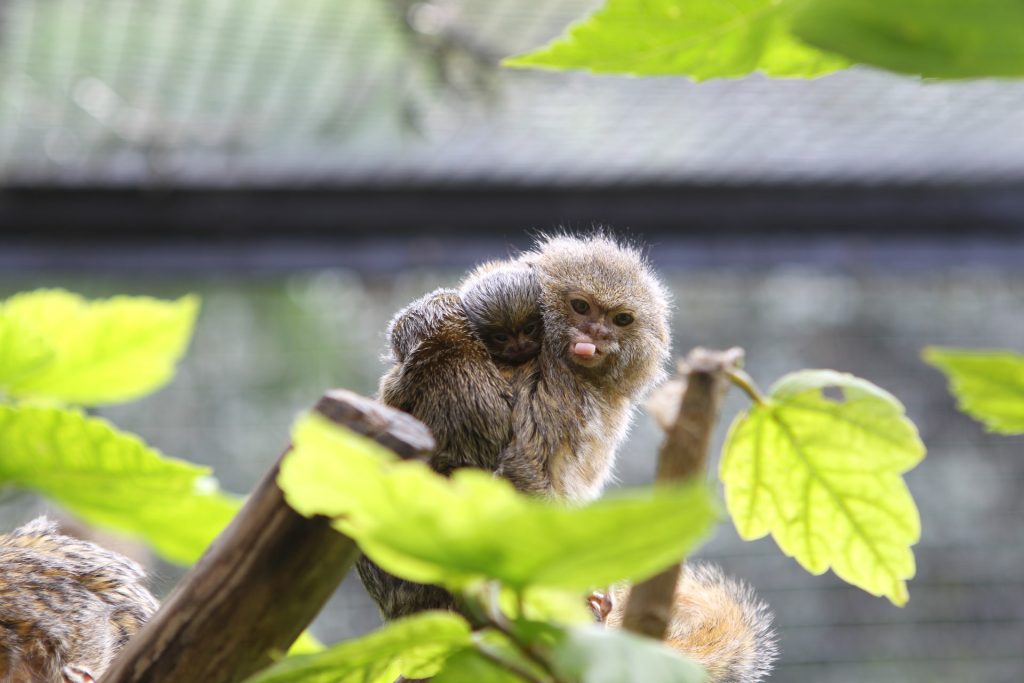About
One of the smallest primates in the world is the Pygmy marmoset. The title of smallest monkey in the world goes to this marmoset. As a result, an adult member of this species is the same size as a stick of butter and fits in the hand of an adult person.
The scientific name of this species is Cebuella pygmaea, while its popular name is finger monkey or pygmy marmoset. They originate from South America and can be found in small groups of 5–10 monkeys in Brazil, Colombia, Northern Bolivia, Ecuador, and Peru.
South America is the only place this species can be found, and there it inhabits the uppermost reaches of the rainforest canopy. Brown fur and an exceptionally long tail that resembles a squirrel are also features of this tiny, adorable monkey.
Even though it isn’t prehensile, the tail is nevertheless highly beneficial because it serves as a prop and helps the animal balance while moving through the treetops. By frequently hiding under tree trunks and branches, as well as by occasionally freezing and running away, this animal generally resembles a squirrel.
Pygmy marmosets are orange-brown, both male and female. Agouti coloration, or brown and black stripes, are present in every hair. They can blend in well thanks to their color.
The pygmy marmoset has ears that are covered in a mane of hair. The majority of primates have opposable thumbs that enable them to grab objects and flat nails on the ends of their fingers. The claw-like fingernails of pygmy marmosets aid in their ability to climb up and down tree trunks. They lack opposable thumbs.
The Pygmy Marmoset, like other marmosets, has claw-like nails that aid in climbing. The tail is marked with black rings and measures 17–23 cm in length, which is longer than the actual body length. Pygmy marmosets have a 12-year lifespan on average.
Since Pygmy Marmoset monkeys are highly social primates, they form stable groups of 2–15 marmosets. These are often family troops, made up of a breeding pair and their children. They typically cuddle up together to sleep at night.
Pygmy Marmoset Family Tree
To meet their entire gum needs, each family has one or two trees in their area. They live and thrive in dense bamboo or forest growth alongside rivers and floodplains.
Pygmy marmosets love to live in deep rainforests with lots of cover from the elements. Each group of marmosets has a modest home range that is less than half an acre. They only eat from a few trees.
They have teeth that have been specially adapted to enable them to eat tiny holes in tree bark to access the sap and gum inside.
Pygmy Marmoset – Food Habit In The Wild

Pygmy Marmosets are omnivores. Every day, they gouge 10 or more new holes out of the bark of trees, returning to both the newer holes and the older ones at various times to gather and consume the gum the tree produces. Additionally, they consume tree sap, fruit, grubs, nectar from flowers, and even spiders.
They use their tongues to taste the tree’s fluid as it emerges. This fluid attracts insects, particularly butterflies, who become victims of the marmoset’s appetite. They may consume spiders as well as smaller insects like grasshoppers. In addition to fruit and nectar, marmoset monkeys eat other things.
Pygmy marmosets at the San Diego Zoo consume vegetables, fruit, and a commercial diet designed specifically for New World monkeys, crickets, mealworms, wax worms, and hard-boiled eggs.
What Do Pet Marmoset Monkeys Eat In Captivity?

Small primates called pygmy monkeys are native to Central and South American rainforests. Pygmy Marmosets eat tree sap, fruits, flowers, leaves, and insects in their natural habitat.
To ensure they get all the nutrients they require, their food must be carefully planned and supervised while they are maintained as pets.
When finger monkeys are adults, they will consume larger portions of a meal that is similar to what they did when they were young. Additionally, they should always have access to clean water.
It’s important to discuss the ideal diet for your pet monkey with your veterinarian, as well as the recommended serving sizes for each type of food. They may assist you in developing a nutritious diet that will satisfy the dietary requirements of your finger monkey.
A Marmoset monkey kept as a pet might eat the following:
- Fresh leaves
- Small or chopped fresh fruits like strawberries, grapes, oranges, and bananas.
- Vegetables like celery, carrots, and leafy greens.
- Cooked legumes or beans.
- Lean protein in small amounts, like cooked chicken or fish.
- Pellets of commercial monkey food.
- Rice cereal.
- Oatmeal.
- Nectars from tropical flowers.
- Bugs and insects.
- Monkey Biscuits”
- Sap and tree gum
Your Pygmy Marmoset will probably be thirsty after all that eating. It’s important to keep your Finger Monkey hydrated. Your small friend might start to have diseases that could be avoided if they don’t get enough to drink. Likewise, you don’t want to give the animal a drink that could be dangerous or unhealthy.
Therefore, be sure to include one of these Finger Monkey favorites on your shopping list:
- The sap of tropical plants
- Clean, fresh water for drinking. Steer clear of water that has been fluoridated.
- Goat or almond milk.
- Fruit juice that has been diluted. Don’t drink concentrated fruit juice.
According to several research, soy products can make adolescents more aggressive as adults. To prevent metabolic bone disease, they must take dietary supplements.
Since marmosets cannot produce vitamin D3 on their own, they should be provided as a supplement.
Feed marmosets multiple times per day to coincide with when they would normally eat. Make sure everyone has access to food by setting out many food dishes and water at various locations.
Set the serving utensils at least one meter above the ground (marmosets prefer to feed and eat higher up where they feel safer, especially if they are carrying infants on their backs).
Marmosets are prone to additional dietary issues (such as tooth issues, being underweight, or being overweight), especially when kept as pets.
Food Enrichment

The marmosets should be fed in a way that promotes their natural foraging, gnawing, insect-catching, fruit-finding, reaching, and eating behaviors.
The curiosity and interest of the marmosets are aroused by the introduction of novel meals and textures.
Importantly, the types and amounts of food utilized for enrichment should be kept to those found in a typical regular diet. Obesity can result from consuming more food.
Important: Before and following the introduction, always evaluate the safety of any enrichment.
Artificial Gum
- The marmosets are enticed to work for the artificial gum by placing it inside bamboo tubes and hanging film canisters.
- Tree gum in the wild can be replaced with Gum Arabic.
Live Insects
- They are very much interested in live insects. Marmosets pursue, scout, and then pounce on them. Some of them are better than others at catching insects.
- The following insects can be introduced without risk: crickets, grasshoppers, and locusts.
Live Mealworms - Live mealworms can be added to sawdust or another substrate to promote foraging.
- To prevent live mealworms from accessing drains and other areas, mealworms can be put inside a sizable perspex box with air holes.
Whole/Unprocessed Food
- To ensure that all the group member get their fair share of the food, it is often chopped up.
- However, keeping the peel on fruits like bananas, apples, or other fruits, or serving peanuts in their shells, increases the time and effort needed to get the nourishment inside.
- To get rid of any pesticides, food should first be thoroughly cleaned.
Scatter Feeding - Dry food can be mixed into the floor substrate to encourage foraging behavior.
- If you want to allow marmosets to forage higher up, where they are more active, scatter feed mix can also be put in an elevated box.
Hanging Fruits
- For example, bananas, apples, and oranges can be hung- whole or cut into segments and stabbed with bamboo skewers.
- Marmosets typically hang upside down in the wild to eat the dangling fruits and flowers.
- This form of enrichment promotes this instinctive behavior.
- The fruits swing, making it difficult for the marmosets to reach the food and forcing them to maintain their balance.
- Juice from frozen fruit (Sugar-free squash)
- Fruit juice can be frozen in plastic cups to make “lollies” that are either hanging or standing.
- As the fluid melts, frozen food can be extracted.
Novelty Food
- An entire peeled banana can be served as a novelty after being slightly frozen.
- The texture and warmth of the banana are surprising, and they alter as it gradually warms to room temp.
What does Baby Pygmy Marmoset Eat?

Newborn pygmy marmosets need to be properly looked after by their parents or humans because they are born small and fragile. Baby monkeys will only consume their mother’s milk for the first few weeks of life.
When they first begin to eat solid foods, their diet will resemble that of an adult monkey, albeit with smaller serving sizes. They will eventually begin to eat more and more solid foods as they get bigger until they are consuming an adult monkey’s diet.
Reference:
Pygmy Marmoset (Finger Monkey) – https://a-z-animals.com/animals/pygmy-marmoset/
Hugues Beaufrere is the Exoticpetia’s senior writer and reptile expert. He has been fascinated by reptiles and monkeys since he was a kid and had years of experience in herpetology and primatology. He has cared for various kinds of Monkeys, Lizards and Reptiles and loves to share his knowledge and passion with others.


